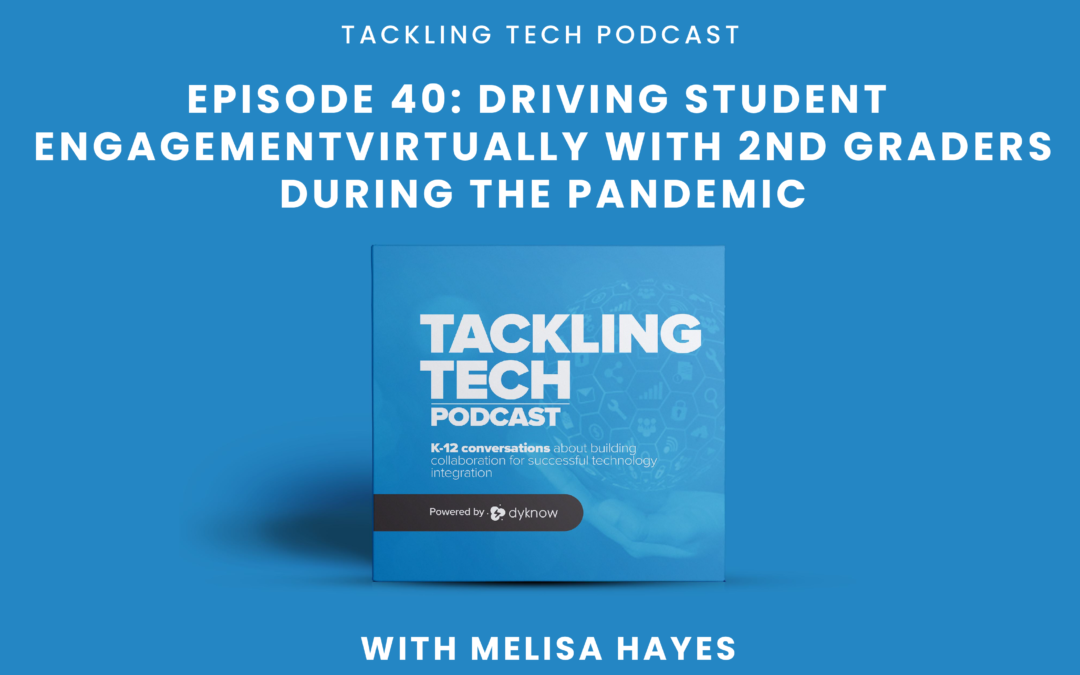On this episode of Tackling Tech Podcast, powered by Dyknow, Brett McGrath interviews Melisa Hayes, a 2nd Grade Teacher in Ohio. Melisa has been teaching remotely since her school started an online academy in response to the pandemic. She shares the creative ways she engages her young students over Zoom, the tools she uses, and how her PLN on Twitter has boosted her confidence as a teacher.
Listen to Episode 40:
Available wherever you listen to podcasts:
Don’t have time to listen to the episode? Here’s a peek at what’s inside…
Teaching in an online academy
Melisa’s district provided an alternate safe environment for the students and parents who were apprehensive about going back to a hybrid learning model, so a lot of teachers got pulled into this online academy that Melisa is now a part of.
It has been a learning curve, especially for elementary teachers and students because they no longer have the interactive elements that in-person teaching provides. Melisa shared with us that she has no background teaching remotely before starting this online learning academy, but luckily, she and all of her colleagues are in the same boat, so they are all learning together.
The experience of teaching elementary students virtually
In Melisa’s experience, technology was the easiest part of shifting to a remote environment because she has always been tech-savvy and interested in learning new strategies and technologies. Her biggest challenge with virtual instruction was making sure that students were excited to come to Zoom classes and be excited even though they were not in the classroom.
Teaching elementary students virtually has given Melisa the unique opportunity to create engagement tactics for remote learning to ensure that students are excited to come to class. She explained that she tried to keep a routine throughout the week with these activities to mix it up, but also make sure students know what to expect.
Remote Elementary Engagement Tactics
- Mystery Zooms – each day, Melisa plans a mystery Zoom for her students where they have a mystery guest come to class and the students have a map and clues so that they can figure out who the mystery guest is, and then the guest will read them a book or teach a lesson
- Teach Me Tuesdays – Each Tuesday, Melisa gives a student the floor so that they can share something with the class like reading a story they wrote, teach the class an app, or share an activity with the class
- STEM Activities – Melisa makes sure to incorporate STEM activities each week to keep students engaged in those subject matters
- Classroom Transformations – Even though Melisa doesn’t have a classroom, once a week she will transform the room that she teaches from and make that the theme of the day for the lessons that she teaches
Personal growth from teaching remotely
Melisa shared that this time of remote teaching has made her more patient, more flexible, and she is more comfortable letting go of control. She reflected that she always gave students control, but now she knows that she doesn’t need to have all the answers or have everything planned out. Melisa has now accepted that if something doesn’t work out, she should laugh it off and keep going because not everything is going to work all the time.
This time has been pretty transformative for Melisa, as she shared that the first week was really hard, and she went above and beyond for her students to make everything perfect. She explained that once she gets on Zoom and sees 25 faces, all the stress for perfection goes away, and she has so much fun with her students.
Using technology for elementary engagement
As Melisa had mentioned, technology had been central for her before remote learning even began. Her district uses Canvas as their portal, but she has also been using many other technology tools to help engage her students.
Some of her favorite apps and websites are Flipgrid, Pic Collage, Apple Clips, iMovie, and various math apps for her lessons.
At the beginning of the week or month, Melisa will usually share an app with the kids, they will play and explore it, and then she will give the students control and they will share what these apps can do with their classmates. She’ll gradually release a new app every week so that students have a suite of tools that they can use for engagement.





